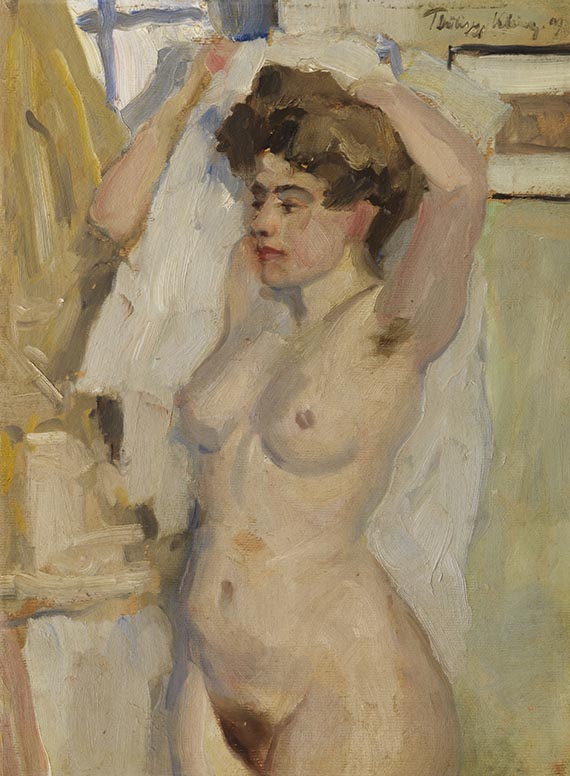645
Philipp Klein
Aktstudie I, 1907.
Oil on cardboard
Estimation:
€ 2,000 / $ 2,140 Résultat:
€ 4,572 / $ 4,892 ( frais d'adjudication compris)
Aktstudie I. 1907.
Oil on cardboard.
Hofkamp PK009. Signed and dated in upper right. With several old labels with hand-written and typographic numbers and inscriptions on the reverse. 60 x 45 cm (23.6 x 17.7 in).
PROVENANCE: From the artist's estate.
Private collectino Southern Germany (family-owned since 1979).
EXHIBITION: Leipziger Kunstverein (with a fragmentarily preserved label on the reverse).
Kollektionen Ulrich Hübner, Philipp Klein, Emil Potter, Emil Rudolf Weiss, Kunstsalon Paul Cassirer, Berlin, April 15 - May 7, 1908.
Nachlass-Ausstellung Philipp Klein, Mannheimer Kunstverein, Mannheim, March - April 1909, no. 3.
Nachlass-Ausstellung Philipp Klein, Kölnischer Kunstverein, Cologne 1909.
Aquarelle, Handzeichnungen und Holzskulpturen erster Meister: darunter der künstlerische Nachlaß von Philipp Klein-München, Kunsthalle P.H. Beyer & Sohn, Leipzig, Nov. 1912, no. 2.
LITERATURE: Katalog der Versteigerung einer Sammlung moderner Ölgemälde, Aquarelle, Handzeichnungen und Holzskulpturen erster Meister: darunter der künstlerische Nachlaß von Philipp Klein-München, P. H. Beyer & Sohn, Leipzig, November 1, 1912, no. 13 [?].
Oil on cardboard.
Hofkamp PK009. Signed and dated in upper right. With several old labels with hand-written and typographic numbers and inscriptions on the reverse. 60 x 45 cm (23.6 x 17.7 in).
PROVENANCE: From the artist's estate.
Private collectino Southern Germany (family-owned since 1979).
EXHIBITION: Leipziger Kunstverein (with a fragmentarily preserved label on the reverse).
Kollektionen Ulrich Hübner, Philipp Klein, Emil Potter, Emil Rudolf Weiss, Kunstsalon Paul Cassirer, Berlin, April 15 - May 7, 1908.
Nachlass-Ausstellung Philipp Klein, Mannheimer Kunstverein, Mannheim, March - April 1909, no. 3.
Nachlass-Ausstellung Philipp Klein, Kölnischer Kunstverein, Cologne 1909.
Aquarelle, Handzeichnungen und Holzskulpturen erster Meister: darunter der künstlerische Nachlaß von Philipp Klein-München, Kunsthalle P.H. Beyer & Sohn, Leipzig, Nov. 1912, no. 2.
LITERATURE: Katalog der Versteigerung einer Sammlung moderner Ölgemälde, Aquarelle, Handzeichnungen und Holzskulpturen erster Meister: darunter der künstlerische Nachlaß von Philipp Klein-München, P. H. Beyer & Sohn, Leipzig, November 1, 1912, no. 13 [?].
Philipp Klein is one of the artists with an impressionist influence who created a spirit of optimism in the German art world at the end of the 19th century. In 1892, Klein came to Munich, the then German art capital, and began to paint as an autodidact, nurtured by exchanges with artist colleagues such as Max Slevogt and Lovis Corinth. As a private student of Josef Wopfner, he stayed with him at Lake Chiemsee and in the foothills of the Alps, and also traveled to the artist colonies in Dachau and Worpswede. Interested in creating an art that was independent from the academic training and the exhibition system, he found a home with the artist group "Die Scholle" around Leo Putz. Like Putz, Klein was also fascinated by the motif of the woman in the landscape and achieved initial success with such subjects at the annual exhibitions in Munich and Berlin. In 1903, he also went to Berlin, where he took part in the Secession’s exhibitions. He was a regular in the program of Galerie Paul Cassirer, which was so important for the development of modern art in Germany. However, his promising career came to an abrupt end when he died early in 1907. Characteristic of his paintings is the freely moving style and the pastel, light-colored palette, which gives the depictions of women their delicate sensuality. Precisely because of the broad strokes, there is a voluminous plasticity, which is also reflected in the often impasto application of paint. The casual execution makes for the special appeal of the present work. [KT]
645
Philipp Klein
Aktstudie I, 1907.
Oil on cardboard
Estimation:
€ 2,000 / $ 2,140 Résultat:
€ 4,572 / $ 4,892 ( frais d'adjudication compris)




 Lot 645
Lot 645 